Botany
| Part of a series on |
| Biology |
|---|
Botany, also called plant science (or plant sciences), plant biology or phytology, is the
Botany originated in prehistory as
In the 19th and 20th centuries, new techniques were developed for the study of plants, including methods of
Modern botany is a broad, multidisciplinary subject with contributions and insights from most other areas of science and technology. Research topics include the study of plant
History
Early botany
Botany originated as
Modern botany traces its roots back to
Another work from Ancient Greece that made an early impact on botany is
In the mid-16th century, botanical gardens were founded in a number of Italian universities. The Padua botanical garden in 1545 is usually considered to be the first which is still in its original location. These gardens continued the practical value of earlier "physic gardens", often associated with monasteries, in which plants were cultivated for suspected medicinal uses. They supported the growth of botany as an academic subject. Lectures were given about the plants grown in the gardens. Botanical gardens came much later to northern Europe; the first in England was the University of Oxford Botanic Garden in 1621.[17]
German physician Leonhart Fuchs (1501–1566) was one of "the three German fathers of botany", along with theologian Otto Brunfels (1489–1534) and physician Hieronymus Bock (1498–1554) (also called Hieronymus Tragus).[18][19] Fuchs and Brunfels broke away from the tradition of copying earlier works to make original observations of their own. Bock created his own system of plant classification.
Physician
Early modern botany
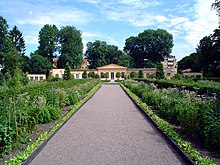
During the 18th century, systems of
Increasing knowledge of
Botany was greatly stimulated by the appearance of the first "modern" textbook,
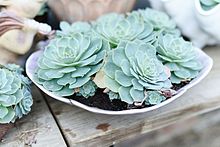
Late modern botany
Building upon the gene-chromosome theory of heredity that originated with Gregor Mendel (1822–1884), August Weismann (1834–1914) proved that inheritance only takes place through gametes. No other cells can pass on inherited characters.[29] The work of Katherine Esau (1898–1997) on plant anatomy is still a major foundation of modern botany. Her books Plant Anatomy and Anatomy of Seed Plants have been key plant structural biology texts for more than half a century.[30][31]

The discipline of
Particularly since the mid-1960s there have been advances in understanding of the physics of

20th century developments in plant biochemistry have been driven by modern techniques of
Modern morphology recognises a continuum between the major morphological categories of root, stem (caulome), leaf (phyllome) and
Scope and importance
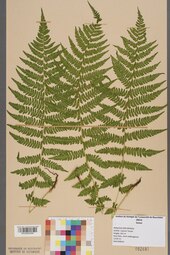
The study of plants is vital because they underpin almost all animal life on Earth by generating a large proportion of the oxygen and food that provide humans and other organisms with aerobic respiration with the chemical energy they need to exist. Plants, algae and cyanobacteria are the major groups of organisms that carry out photosynthesis, a process that uses the energy of sunlight to convert water and carbon dioxide[54] into sugars that can be used both as a source of chemical energy and of organic molecules that are used in the structural components of cells.[55] As a by-product of photosynthesis, plants release oxygen into the atmosphere, a gas that is required by nearly all living things to carry out cellular respiration. In addition, they are influential in the global carbon and water cycles and plant roots bind and stabilise soils, preventing soil erosion.[56] Plants are crucial to the future of human society as they provide food, oxygen, biochemicals, and products for people, as well as creating and preserving soil.[57]
Historically, all living things were classified as either animals or plants
The strictest definition of "plant" includes only the "land plants" or
Among the important botanical questions of the 21st century are the role of plants as primary producers in the global cycling of life's basic ingredients: energy, carbon, oxygen, nitrogen and water, and ways that our plant stewardship can help address the global environmental issues of
Human nutrition
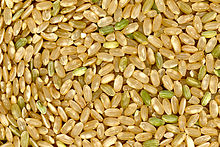
Virtually all staple foods come either directly from
Botanists study how plants produce food and how to increase yields, for example through
Plant biochemistry
Plant biochemistry is the study of the chemical processes used by plants. Some of these processes are used in their
Plants and various other groups of photosynthetic eukaryotes collectively known as "
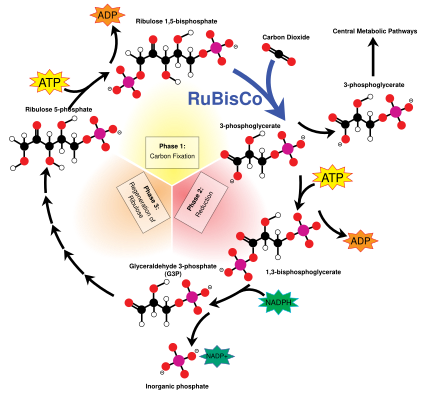
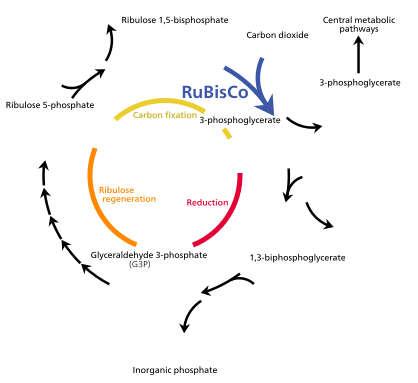
(G3P)
The light energy captured by
Unlike in animals (which lack chloroplasts), plants and their eukaryote relatives have delegated many biochemical roles to their
Plants synthesise a number of unique polymers like the polysaccharide molecules cellulose, pectin and xyloglucan[86] from which the land plant cell wall is constructed.[87] Vascular land plants make
Medicine and materials
Plants can synthesise coloured dyes and pigments such as the anthocyanins responsible for the red colour of red wine, yellow weld and blue woad used together to produce Lincoln green, indoxyl, source of the blue dye indigo traditionally used to dye denim and the artist's pigments gamboge and rose madder.
Sugar,
Plant ecology
Plant ecology is the science of the functional relationships between plants and their habitats – the environments where they complete their life cycles. Plant ecologists study the composition of local and regional floras, their biodiversity, genetic diversity and fitness, the adaptation of plants to their environment, and their competitive or mutualistic interactions with other species.[100] Some ecologists even rely on empirical data from indigenous people that is gathered by ethnobotanists.[101] This information can relay a great deal of information on how the land once was thousands of years ago and how it has changed over that time.[101] The goals of plant ecology are to understand the causes of their distribution patterns, productivity, environmental impact, evolution, and responses to environmental change.[102]
Plants depend on certain
Plants, climate and environmental change
Plant responses to climate and other environmental changes can inform our understanding of how these changes affect ecosystem function and productivity. For example, plant
Genetics
Inheritance in plants follows the same fundamental principles of genetics as in other multicellular organisms.
Species boundaries in plants may be weaker than in animals, and cross species
Charles Darwin in his 1878 book The Effects of Cross and Self-Fertilization in the Vegetable Kingdom[120] at the start of chapter XII noted “The first and most important of the conclusions which may be drawn from the observations given in this volume, is that generally cross-fertilisation is beneficial and self-fertilisation often injurious, at least with the plants on which I experimented.” An important adaptive benefit of outcrossing is that it allows the masking of deleterious mutations in the genome of progeny. This beneficial effect is also known as hybrid vigor or heterosis. Once outcrossing is established, subsequent switching to inbreeding becomes disadvantageous since it allows expression of the previously masked deleterious recessive mutations, commonly referred to as inbreeding depression.
Unlike in higher animals, where
Most sexually reproducing organisms are diploid, with paired chromosomes, but doubling of their
As in other eukaryotes, the inheritance of
Molecular genetics

A considerable amount of new knowledge about plant function comes from studies of the molecular genetics of
Agrobacterium tumefaciens, a soil rhizosphere bacterium, can attach to plant cells and infect them with a callus-inducing Ti plasmid by horizontal gene transfer, causing a callus infection called crown gall disease. Schell and Van Montagu (1977) hypothesised that the Ti plasmid could be a natural vector for introducing the Nif gene responsible for nitrogen fixation in the root nodules of legumes and other plant species.[133] Today, genetic modification of the Ti plasmid is one of the main techniques for introduction of transgenes to plants and the creation of genetically modified crops.
Epigenetics
Epigenetic changes in
Unlike animals, many plant cells, particularly those of the parenchyma, do not terminally differentiate, remaining totipotent with the ability to give rise to a new individual plant. Exceptions include highly lignified cells, the sclerenchyma and xylem which are dead at maturity, and the phloem sieve tubes which lack nuclei. While plants use many of the same epigenetic mechanisms as animals, such as chromatin remodelling, an alternative hypothesis is that plants set their gene expression patterns using positional information from the environment and surrounding cells to determine their developmental fate.[138]
Epigenetic changes can lead to paramutations, which do not follow the Mendelian heritage rules. These epigenetic marks are carried from one generation to the next, with one allele inducing a change on the other.[139]
Plant evolution
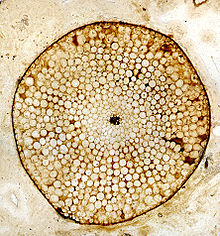
The
The
Nonvascular land plants are
Plant physiology
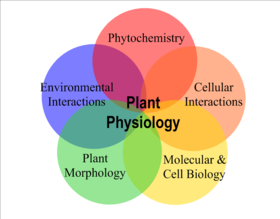
Plant physiology encompasses all the internal chemical and physical activities of plants associated with life.[152] Chemicals obtained from the air, soil and water form the basis of all plant metabolism. The energy of sunlight, captured by oxygenic photosynthesis and released by cellular respiration, is the basis of almost all life. Photoautotrophs, including all green plants, algae and cyanobacteria gather energy directly from sunlight by photosynthesis. Heterotrophs including all animals, all fungi, all completely parasitic plants, and non-photosynthetic bacteria take in organic molecules produced by photoautotrophs and respire them or use them in the construction of cells and tissues.[153] Respiration is the oxidation of carbon compounds by breaking them down into simpler structures to release the energy they contain, essentially the opposite of photosynthesis.[154]
Molecules are moved within plants by transport processes that operate at a variety of spatial scales. Subcellular transport of ions, electrons and molecules such as water and enzymes occurs across cell membranes. Minerals and water are transported from roots to other parts of the plant in the transpiration stream. Diffusion, osmosis, and active transport and mass flow are all different ways transport can occur.[155] Examples of elements that plants need to transport are nitrogen, phosphorus, potassium, calcium, magnesium, and sulfur. In vascular plants, these elements are extracted from the soil as soluble ions by the roots and transported throughout the plant in the xylem. Most of the elements required for plant nutrition come from the chemical breakdown of soil minerals.[156] Sucrose produced by photosynthesis is transported from the leaves to other parts of the plant in the phloem and plant hormones are transported by a variety of processes.
Plant hormones
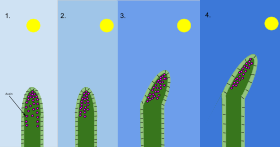
2 With the sun at an angle and only shining on one side of the shoot, auxin moves to the opposite side and stimulates cell elongation there.
3 and 4 Extra growth on that side causes the shoot to bend towards the sun.[157]
Plants are not passive, but respond to
The hypothesis that plant growth and development is coordinated by
Another class of
In addition to being the primary energy source for plants, light functions as a signalling device, providing information to the plant, such as how much sunlight the plant receives each day. This can result in adaptive changes in a process known as photomorphogenesis. Phytochromes are the photoreceptors in a plant that are sensitive to light.[173]
Plant anatomy and morphology
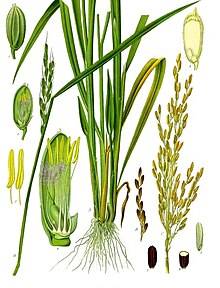
Plant anatomy is the study of the structure of plant cells and tissues, whereas plant morphology is the study of their external form.[174]
All plants are multicellular eukaryotes, their DNA stored in nuclei.














